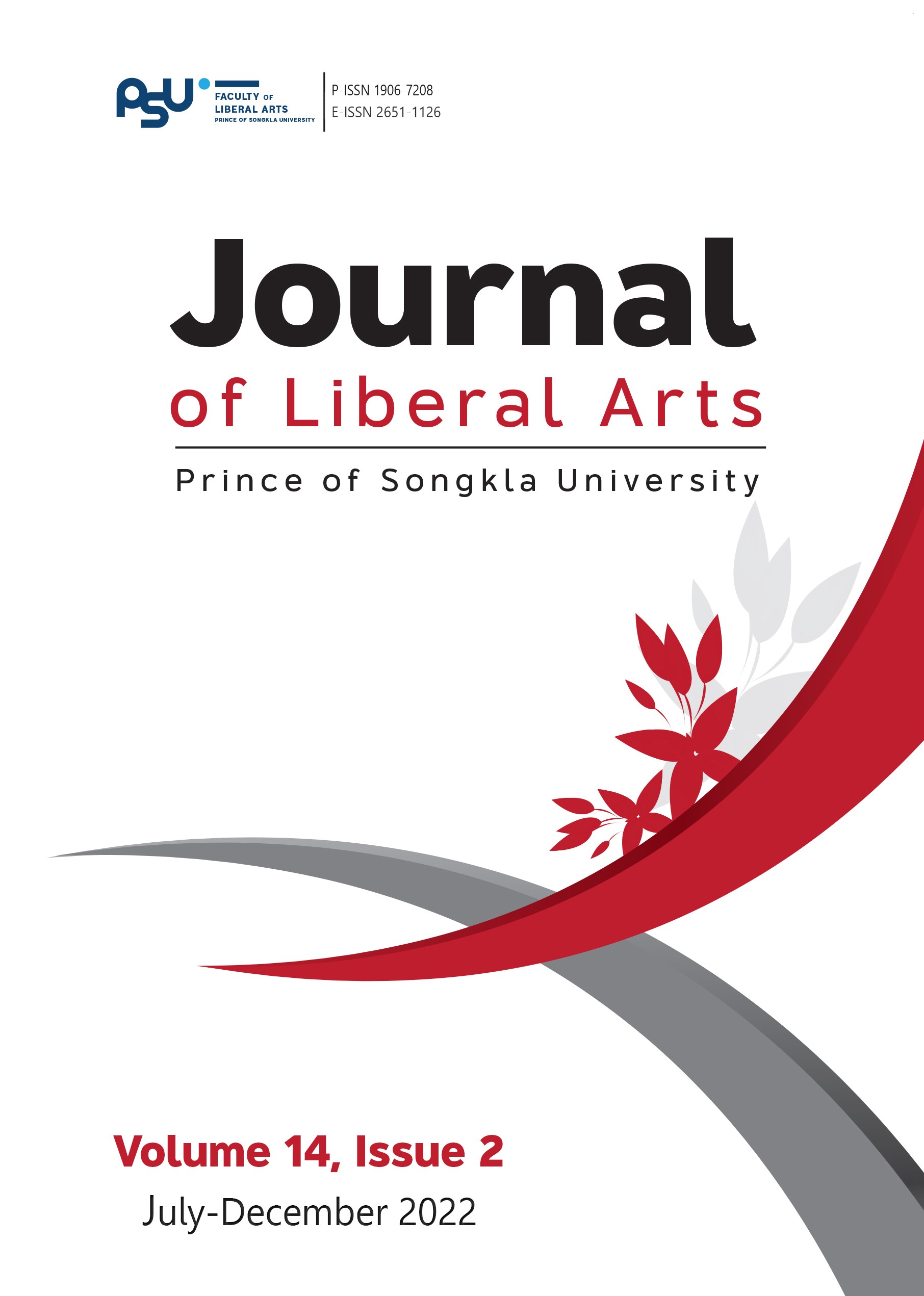วิธีแบบสื่อวีดีทัศน์เปรียบเทียบกับสื่อโสตทัศน์เพียงอย่างเดียวเพื่อพัฒนาทักษะการฟังภาษาจีนของผู้เรียนในฐานะภาษาที่สอง
DOI:
https://doi.org/10.14456/jlapsu.2022.19คำสำคัญ:
การสอน, การฟังเพื่อความเข้าใจ , สื่อวีดิทัศน์, สื่อโสตทัศน์ , ภาษาจีนในฐานะภาษาที่สอง/ภาษาต่างประเทศบทคัดย่อ
การใช้สื่อวิดิทัศน์สำหรับการสอนทักษะการฟังถูกนำไปประยุกต์ใช้อย่างแพร่หลายในการเรียนภาษาต่างประเทศในฐานะภาษาที่สอง แต่กลับมีงานวิจัยด้านการใช้สื่อดังกล่าวสำหรับการสอนภาษาจีนในฐานะภาษาที่สองหรือภาษาต่างประเทศเพียงเล็กน้อย รวมไปถึงการใช้วัดผลสัมฤทธิ์ทางการศึกษา วัตถุประสงค์งานวิจัยจัดทำเพื่อประเมินประสิทธิภาพการใช้สื่อวิดิทัศน์เปรียบเทียบกับการใช้สื่อโสตทัศน์เพียงอย่างเดียวเพื่อพัฒนาทักษะการฟังภาษาต่างประเทศของนักศึกษาสองกลุ่ม ได้แก่ กลุ่มควบคุม (สื่อโสตทัศน์เพียงอย่างเดียว) และกลุ่มทดลอง (สื่อโสตทัศน์และวิดิทัศน์) โดยแต่ละกลุ่มประกอบด้วยผู้เข้าร่วม 30 คน จากรอบปีการศึกษาที่ต่างกัน คัดเลือกจากการลงทะเบียนเรียนวิชาทักษะการฟังภาษาจีน (ระดับความรู้ HSK 4 ถึง 5) ณ มหาวิทยาลัยในประเทศไทย โดยที่ข้อมูลประกอบขึ้นจากคำถามทั้งหมดสี่ประเภท ได้แก่ แบบทดสอบวัดความเข้าใจโดยรวม แบบทดสอบชนิดคำตอบถูก-ผิด แบบทดสอบชนิดปรนัยและแบบทดสอบประเภทคำศัพท์ คะแนนเฉลี่ยของแต่ละส่วนมาจากวิธีการทดสอบความแตกต่างค่าเฉลี่ย ผลการศึกษาพบความต่างที่มีนัยสำคัญทางสถิติต่อกลุ่มทดลอง ที่มีต่อแบบทดสอบประเภทวัดความเข้าใจโดยรวม แบบทดสอบชนิดคำตอบถูก-ผิด และแบบทดสอบชนิดปรนัย ในทางกลับกันไม่พบความต่างที่มีนัยสำคัญทางสถิติของกลุ่มควบคุม เช่นเดียวกับกลุ่มทดลอง ในส่วนของแบบทดสอบประเภทคำศัพท์ ผลการวิจัยสามารถแนะนำได้ว่าการใช้สื่อวีดิทัศน์เป็นวิธีที่มีประสิทธิภาพต่อการสอนภาษาจีนในฐานะภาษาที่สองหรือภาษาต่างประเทศ แต่ไม่สามารถสรุปได้ว่ามีประสิทธิภาพต่อกระบวนการเรียนรู้เรื่องของคำศัพท์
References
Bagheri, M., & Karami, S. (2014). The effect of explicit teaching of listening strategies and gender on EFL learners’ IELTS performance. Journal of Language Teaching & Research, 5(6). https://doi.org/10.4304/JLTR.5.6.1387-1392
Basal, A., Gülözer, K., & Demir, İ. (2015). Use of video and audio texts in EFL listening test. Journal of Education and Training Studies, 3(6), 83-89. http://jets.redfame.com
Batty, A. O. (2021). An eye-tracking study of attention to visual cues in L2 listening tests. Language Testing, 38(4), 511-535. https://doi.org/10.1177/0265532220951504
Bond, C. D. (2012). An overview of best practices to teach listening skills. International Journal of Listening, 26(2), 61-63.
https://doi.org/10.1080/10904018.2012.677660
Chan, C. , Lei, W., & Lena, X. (2014). A study of video effects on English listening comprehension. Studies in Literature and Language, 8(2), 53-58. http://dx.doi.org/10.3968/n
Chang, A. C. S., & Read, J. (2013). Investigating the effects of multiple-choice listening test items in the oral versus written mode on L2 listeners' performance and perceptions. System, 41(3),575-586. https://doi.org/10.1016/j.system.2013.06.
Chayanuvat, A. (2021). Effectiveness of a blended learning model for teaching Chinese listening skills to mathayom suksa four Thai students. APHEIT International Journal, 10(2), 57-75. http://dx.doi.org/10.18823/asiatefl.2020.17.4.14.1377
Chen, C. M., & Chen, I. C. (2021). The effects of video-annotated listening review mechanism on promoting EFL listening
comprehension. Interactive Learning Environments, 29(1), 83-97.https://doi.org/10.1080/10494820.2019.1579232
Elekaei, A., Faramarzi, S., & Biria, R. (2015). Test-takers' attitudes toward taking pictorial and visual modalities of listening comprehension test in an EFL context. Journal of Language Teaching & Research, 6(2). https://www.researchgate.
net/publication/264237508
Ewe, L. C., & Min, F. (2021). Teaching Chinese language outside of China: The case of Chinese teachers in Thailand. Asia-Pacific Social Science Review, 21(4). DOI:10.1163/26659077-00703003
Ghorbanpour, E., Abbasian, G. R., & Mohseny, A. (2021). Assessment alternatives in developing L2 listening ability: Assessment FOR, OF, AS learning or integration? (assessment x̄ approach). International Journal of Language Testing, 11(1), 36-57. https://www.ijlt.ir/article_128359.html
Gou, C. X. (2016) Research on the teaching of elementary Chinese listening as a foreign language aided by multimedia. Journal of Lanzhou University, 08, 51. https:// kns.cnki.net/kcms/detail/detail.aspx?FileName=1016724327.nh&DbName=
CMFD2016
Hardiah, M. (2019). Improving students listening skill by using audio visual media. Al-Lughah: Journal Bahasa, 7(2), 39-49. http://dx.doi.org/10.29300/lughah.v7i2.1673
Hidri, S. (2014). Developing and evaluating a dynamic assessment of listening comprehension in an EFL context. Language Testing in Asia, 4(1), 1-19. https://doi.org/10.1186/2229-0443-4-4
Hemmati, F., & Ghaderi, E. (2014). The effect of four formats of multiple-choice questions on the listening comprehension of EFL learners. Procedia-Social and Behavioral Sciences, 98, 637-644. https://doi.org/10.1016/j.sbspro.2014.03.462
Iftanti, E., & Prastiyo, J. T. (2021). Anxiety confronted by EFL student in instructional listening class. Ta'dib, 24(2), 69-78. http://
dx.doi.org/10.31958/jt.v24i2.4720
Keihaniyan, M. (2013). Multimedia and listening skills. International Journal of Advanced Research, 1(9), 608-617. http://jurnal.
unsyiah.ac.id/EEJ/article/view/12512
Kim, Hea-Suk. (2015). Using authentic videos to improve EFL students’ listening comprehension. International Journal of Contents, 11(4),15–24. https://doi.org/10.5392/IJOC.2015.11.4.015
Lee, S. P., Lee, S. D., Liao, Y. L., & Wang, A. C. (2015). Effects of audio-visual aids on foreign language test anxiety, reading and listening comprehension, and retention in EFL learners. Perceptual and Motor Skills, 120(2), 576-590. https://doi.org/
2466/24.PMS.120v14x2
Li, C. H. (2016). A comparative study of video presentation modes in relation to L2 listening success. Technology, Pedagogy, and Education, 25(3), 301-315. https://doi.org/10.1080/1475939X.2015.1035318
Li, Y. (2016). English and Thai speakers' perception of Mandarin tones. English Language Teaching, 9(1), 122-132.
https://files.eric.ed.gov/fulltext/EJ1087096.pdf
Lu, D. Y. (2014) The teaching of elementary Chinese listening as a foreign language aided by multimedia. Journal of Bohai University, 08, 40. https://kns.cnki. net/kcms/detail/detail.aspx?FileName=1014247443.nh&DbName=CMFD2014
Loon, L. H. (2019). Towards meeting elementary MFL learners’ needs through audio-visual materials in conjunction to Mandarin drama series & movies. Journal Linguistic, 23(2). https://plm.org.my/ejurnal/index.php/jurnallinguistik/article/view/68
Lynch, T., & Mendelsohn, D. (2013). Listening. In T. Schmitt (Ed.), An introduction to applied linguistics (pp. 190-206).Routledge
Ma, X. (2016) Research on the application of multimedia in teaching elementary Chinese listening as a foreign language. Journal of Xi'an Foreign Language University, 05,65.https://kns.cnki.net/kcms/detail/detail.aspx FileName=1016760335.nh&DbName
=CMFD2016
Mathew, N. G., & Alidmat, A. O. H. (2013). A study on the use usefulness of audio-visual aids in EFL classroom: Implications for effective instruction. International Journal of Higher Education, 2(2), 86-92. http://www.sciedupress.com/ijhe
Memarzadeh, M., & Shariati, M. (2015). Video clips used as an assessment tool in listening placement tests. International Journal of English Language Teaching, 3(8), 56-70.www.eajournals.org
Namaziandost, E., & Nasri, M. (2019). The impact of using audio-visual aids on teaching listening among Iranian pre-intermediate EFL learners. LLT Journal: A Journal on Language and Language Teaching, 22(2), 246-259. https://doi.org/10.24071/llt.2019.220209
Polat, M., & Eristi, B. (2019). The effects of authentic video materials on foreign language listening skill development and listening anxiety at different levels of English proficiency. International Journal of Contemporary Educational Research, 6(1), 135-154. https://doi.org/10.33200/ijcer.567863
Rukthong, A., & Brunfaut, T. (2020). Is anybody listening? The nature of second language listening in integrated listening-to-summarize tasks. Language Testing, 37(1), 31-53. https://doi.org/10.1177/0265532219871470
Suvorov, R. (2015). The use of eye tracking in research on video-based second language (L2) listening assessment: A comparison of context videos and content videos. Language Testing, 32(4), 463-483. https://doi.org/10.1177/0265532214562099
Tran, T. Q., & Duong, T. M. (2020). Insights into listening comprehension problems: A case study in Vietnam. PASAA: Journal of Language Teaching and Learning in Thailand, 59, 77-100. https://www.coursehero.com/file/97667578/3docx/
Wang, M. Y. (2019) An overview of the application of video materials in teaching Chinese as a foreign language. Changjiang Journal, 25 (2), 99-101. https://kns.cnki.net/kns8/manage/export?filename=cjck201925040&dbname=CJFDLASN2019
Wang X.L. (2010). Happy Chinese - An audiovisual oral Chinese course for intermediate and advanced students 1 (with 1 MP3 and 1 DVD). Peking University Press.
Xiao, B. X. (2017). The application of audio-visual material for teaching advanced listening of Chinese as a foreign language. Journal of Xi'an Foreign Language University, 08, 69 https://kns.cnki.net/kcms/detail/detail.aspx?FileName=101
nh&DbName=CMFD2017
Xinyu, L. (2017). The implementation of Chinese nursery rhymes to improve Mandarin pronunciation among primary students
at a school in Pathum Thani Province. Rangsit Journal of Educational Studies, 4(2), 90-111. https://pkp.sfu.ca/ojs/
Yildiz, T. A. (2017). The effect of videos with subtitles on vocabulary learning of EFL learners. Int. J. Humanit. Soc. Sci, 7, 125- 130. doi: 10.19030/tlc.v7i9.146
Zhang, L. L. (2013). A tentative study on visual support in beginning Chinese listening classes. Journal of Huazhong University of Science and Technology, 06, 51. https://kns.cnki.net/kcms/detail/detail.aspx?FileName=1014029894.nh&DbName=CMFD2014
Zhang, Y.(2012). A preliminary study on multimedia-assisted teaching for Chinese as a foreign language. Journal
of Zhejiang University, 08,41. https://chn.oversea. cnki.net/kcms/detail/detail.aspx?FileName=1012332384.nh&DbName=CMFD2012
Zheng, Y., & Samuel, A. G. (2019). How much do visual cues help listeners in perceiving accented speech? Applied Psycholinguistics, 40(1), 93-109. https://doi.org/10.1017/S0142716418000462
Downloads
เผยแพร่แล้ว
How to Cite
ฉบับ
บท
License
Copyright (c) 2022 Chunyu Wang

This work is licensed under a Creative Commons Attribution-NonCommercial-NoDerivatives 4.0 International License.
ลิขสิทธิ์บทความเป็นของผู้เขียน แต่วารสารศิลปศาสตร์ มหาวิทยาลัยสงขลานครินทร์ ขอสงวนสิทธิ์ในการเป็นผู้ตีพิมพ์เผยแพร่เป็นครั้งแรก




